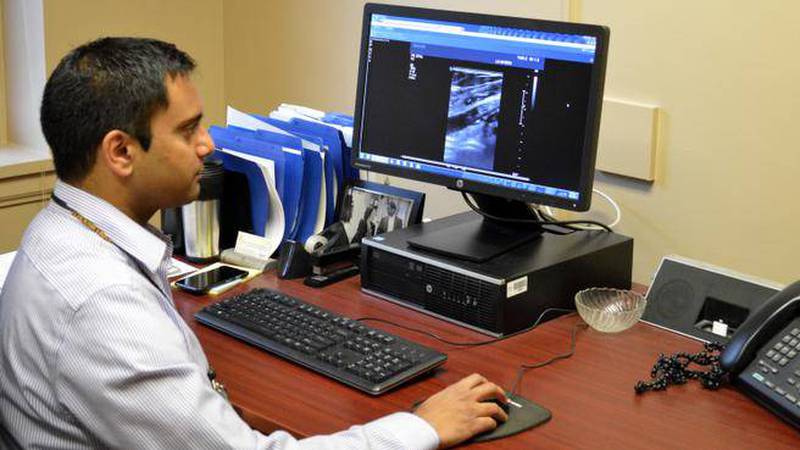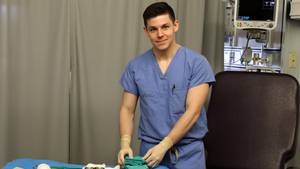As a top-tier hockey player for an American university, 22-year-old Shannon Macaulay is accustomed to testing her physical limits. But a trip to the gym in April 2016 turned out to be anything but routine.
Within a few hours, Shannon started to feel “extreme fatigue” in her arm and her veins became dilated. Like many athletes, she tried to power through it until she noticed that her arm was very swollen. Admitting that something was seriously wrong, she sought help right away.
“My trainers sent me to the hospital. At first I was told that it might be an allergic reaction, but after an ultrasound I found out that it was a blood clot. I was then referred to the QEII Health Sciences Centre.”
According to Dr. Sudeep Shivakumar, director of the thrombosis and anticoagulation program at the QEII and an associate professor at Dalhousie University, Shannon is among “one person in a thousand” who will experience some sort of blood clot, or thrombosis, every year.
“On average we see about 20-30 patients a month here with a newly diagnosed blood clot,” he says.
Even though the odds of experiencing a blood clot aren’t remote, Dr. Shivakumar says they typically develop under different circumstances.
“Surgery can increase your risk by 20 to 25 times more than usual. Cancer increases your risk more than five times because it makes the blood ‘sticky.’ You’re also more likely to be in bed for long periods of time, receive radiation therapy and some of the chemotherapy drugs will increase the risk.”
“The birth control pill increases the risk about five times more than usual,” he continues. “When you’re looking at young, healthy women who are otherwise out of the medical system, and how many people are on the birth control pill, that’s a large number of the population.”
According to Dr. Shivakumar, blood clots can manifest in several different ways. Beyond relatively-benign but still-troublesome superficial clots, Shannon’s experience with deep-vein thrombosis, or DVT, represents an escalation in severity.
“The classic symptoms for DVT are pain in the back of the calf, like a charley horse that doesn’t go away,” Dr. Shivakumar illustrates. “It’s usually accompanied by swelling, redness and warmth. So, if you have one leg swollen more than the other, DVT is the most probable cause.”
But perhaps the most dangerous manifestation of thrombosis is a pulmonary embolism in the lungs.
“If it’s not treated, a pulmonary embolism can cause shortness of breath, chest pains, a strain on your heart, low blood pressure and it can even be fatal,” warns Dr. Shivakumar.
Since the 1950s, warfarin has been prescribed as a blood thinner to de-escalate the condition. And even though the drug is largely effective for most patients, some find it challenging to adjust their lifestyle to taking warfarin.
“Warfarin interacts with Vitamin K, which is in green, leafy vegetables,” Dr. Shivakumar explains. “You have to adjust the dose based on how much of it you eat, which means regular blood work, a lot of back and forth to the lab and phone calls to tell patients how much to take. It also interacts with a lot of medications. But in the last six years, there’s been an explosion of new drugs that are now available.”
One of these newer options proved particularly beneficial to Shannon.
“I didn’t experience any side effects aside from bruising easily,” she says.
Dr. Shivakumar is also encouraged by the results he’s seen thus far.
“These drugs don’t require any routine blood tests, there’s no monitoring needed, there’s no interactions with food and much less interaction with medications.”
As advanced as these new drugs are, Dr. Shivakumar stresses that prevention is always superior to treatment.
“If you’re on a long flight or car trip, get up and walk around every several hours and keep yourself hydrated. If you’re going in for surgery and you’ve had a blood clot before, tell your health care provider and they may give you blood thinners as a preventative measure. Also, if you’re at risk for a blood clot, have a discussion with your doctor about the birth control pill, or if you’re pregnant, because that’s when women are at a higher risk.”
“The main thing is be aware of your body,” he concludes. “Look for symptoms and if you get them, get checked out.”
Shannon, who is now almost “back to 100 per cent,” is quick to mirror this advice.
“Typically I’d be the type of person who wouldn’t go to the doctor,” she says. “But I’m really glad I went in, because it could have been a lot worse.”








